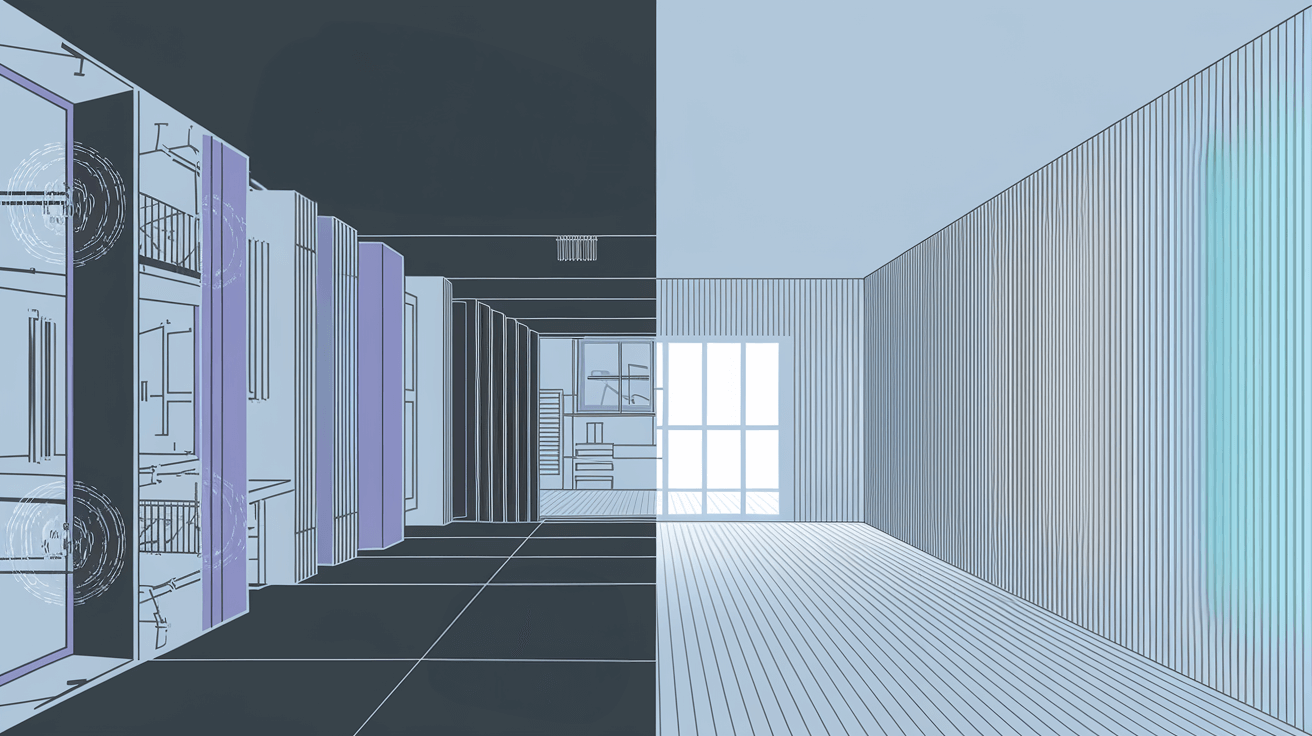Wondering how well soundproofing really works—or if it’s worth the effort? STC and IIC ratings hold the answers, measuring noise-blocking power with precision straight from the lab.
Soundproofing isn’t magic—it’s science, and these ratings tell you exactly how much noise stays out of your space. This guide unpacks them step-by-step, turning technical jargon into real-world solutions you can use today.
If you’re new to noise control—or just need a refresher—start with Soundproofing Basics: Everything You Need To Know To Get Started. It’s the foundation for understanding why these numbers matter and how they fit into silencing your world.
Noise isn’t just an annoyance—it’s a sleep thief, a focus killer, and even a health hazard when it’s relentless. STC and IIC ratings cut through the chaos, giving you a clear yardstick to measure soundproofing’s punch against everything from barking dogs to stomping upstairs neighbors.
Whether you’re soundproofing a home office, an apartment, or a recording studio, these ratings are your roadmap. Let’s break them down so you can pick the right materials and know what “quiet” really means.
What Does STC Rating Mean?
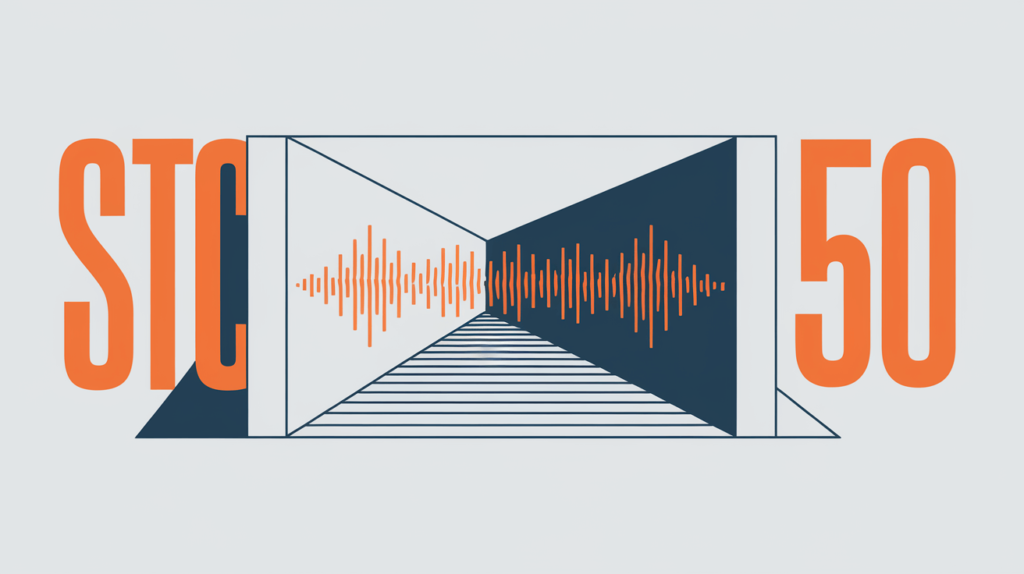
STC stands for Sound Transmission Class—it’s a number from 0 to 100 that shows how much airborne sound a barrier stops. A wall with an STC of 50 cuts noise by about 50 decibels—think a loud conversation dropping to a faint whisper on the other side.
Airborne noise is anything traveling through the air—TV chatter, street traffic, or a neighbor’s shouting match. STC tells you how well your walls, ceilings, or doors hold that noise back, keeping your space quieter.
For example, a standard drywall wall might hit STC 35—loud voices still leak through, annoying but audible. Double it up with insulation, and STC 50+ turns that racket into background hum—peace restored with a bit of mass.
This isn’t just theory—builders use STC to spec apartments or offices where privacy’s non-negotiable. Need the full scoop on soundproofing’s basics? Check noise reduction explained for how these barriers work their magic.
The higher the STC, the better—60+ is studio-grade, blocking nearly all chatter. It’s your first clue to whether that “soundproof” material is worth the price tag.
What Does IIC Rating Mean?
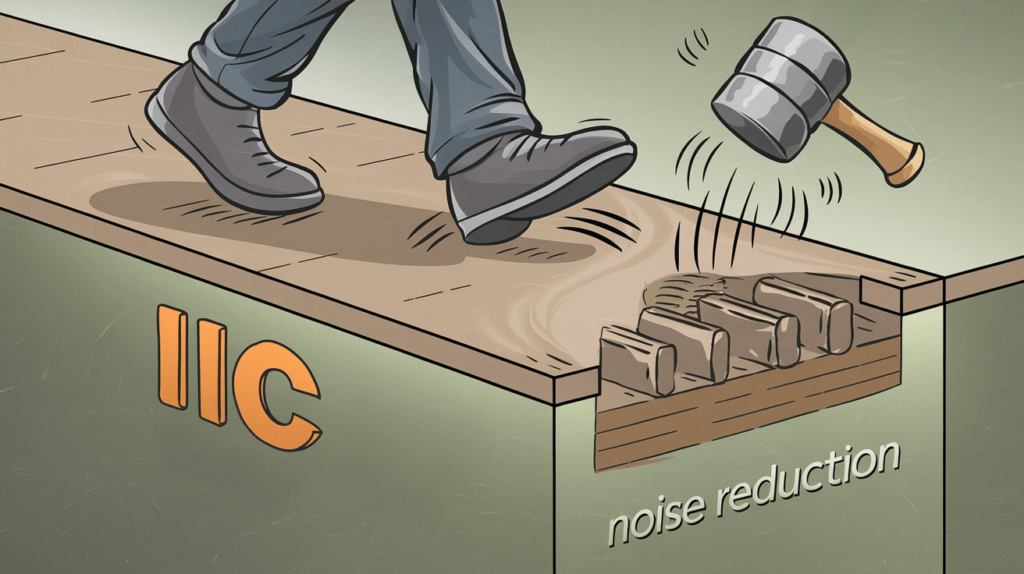
IIC, or Impact Insulation Class, measures how well a floor dampens impact noise—think footsteps, dropped tools, or kids jumping—also scored from 0 to 100. An IIC of 55 means those upstairs thuds soften enough to keep downstairs livable, not a war zone.
Impact noise is different—it’s physical vibrations hitting a surface, not just air waves. IIC tests floors specifically, rating how much of that clatter transfers below—crucial for apartments or two-story homes.
Take a bare hardwood floor—IIC 25 lets every step pound through like a drum. Add carpet and padding, and IIC 50+ turns it into a dull tap—your downstairs neighbor might actually thank you.
This matters in multi-level buildings—codes often demand IIC 50 minimum for condos. Noise types shape the fix, so dig into difference between airborne and impact noise to see why IIC is a big deal.
Higher IIC scores mean thicker floors or better underlayment—65+ is luxury quiet. It’s about stopping the shake before it becomes someone else’s problem.
How Are STC and IIC Ratings Tested?
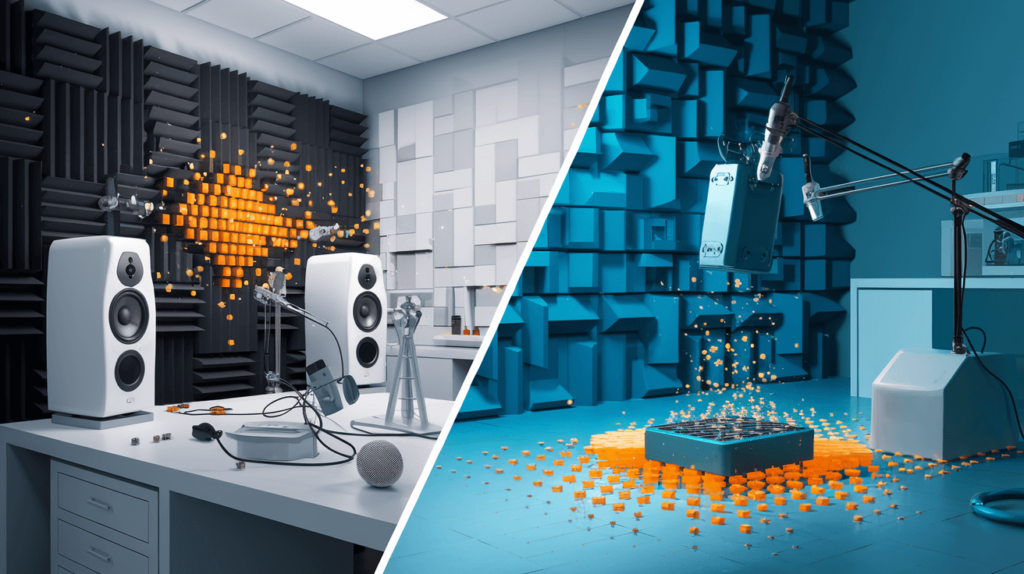
STC testing blasts sound—like speech or music—from speakers on one side of a wall, measuring what sneaks through with mics on the other—labs keep it controlled for precision. IIC uses a tapping machine, dropping steel hammers on a floor while recording the noise below—mimicking real footsteps or bangs.
These aren’t backyard experiments—ASTM standards (E90 for STC, E492 for IIC) ensure consistency across materials. Labs isolate frequencies—low bass to high shouts—then average them into a single rating, reflecting everyday noise battles.
For STC, they crank up sound until it’s loud—say, 80 dB—then check the drop across the barrier. A 50 STC wall might let 30 dB through—quiet enough to sleep through most nights.
IIC’s machine taps rhythmically—five hammers, 10 hits per second—simulating a busy upstairs. An IIC 50 floor cuts that racket by half, turning chaos into calm—test data you can trust.
This isn’t guesswork—manufacturers use these numbers to sell drywall, flooring, or insulation. Curious if it holds up in your space? See does soundproofing work for real results.
The process is technical but practical—ratings come from controlled chaos, not hype. It’s how pros know a wall or floor will deliver silence before the hammer swings.
Why Do STC and IIC Ratings Matter for Soundproofing?

STC and IIC ratings predict how quiet your space will be—STC 40 walls let conversations slip through; 60 stops most cold. IIC 50 floors dull footsteps; 65 kills them dead—vital for picking materials that match your noise woes.
They’re not just numbers—they’re your shield against disappointment or wasted cash. A cheap STC 30 partition sounds flimsy because it is—ratings reveal what “soundproof” really means.
In an apartment, STC 45 might handle light chatter, but 55+ blocks late-night parties—peace isn’t optional. IIC 50 keeps upstairs stomping bearable; 60+ makes it a ghost town—essential for shared walls or floors.
These ratings guide builders—codes demand STC 50+ in multi-family units for a reason. Wondering why soundproofing’s worth it? Check reasons to soundproof for the bigger picture.
Without them, you’re guessing—STC and IIC turn vague promises into hard facts. They’re the difference between “kinda quiet” and “pin-drop silent” when the job’s done.
What’s a Good STC or IIC Rating for Your Space?
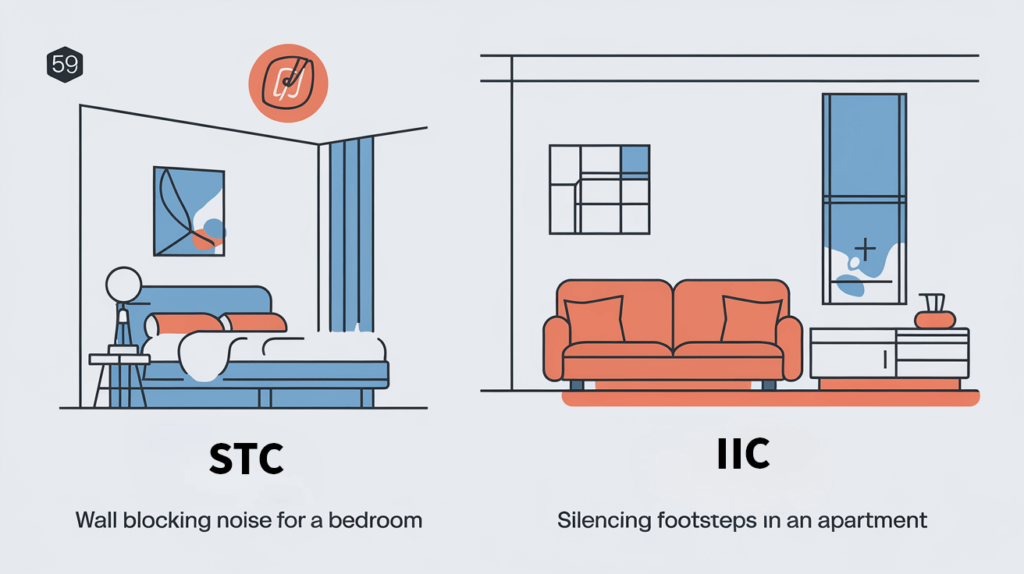
For homes, aim for STC 50+—it quiets traffic or voices; 60+ is studio-grade, nearly soundproof against daily noise. IIC 50+ works for apartments—muffling steps—while 65+ is luxury, turning floors into silent zones—balance cost against your sanity.
Context matters—a suburban house might scrape by with STC 45, but city apartments need 55+ to fight street buzz. IIC 50 meets most building codes, but 60+ is gold if upstairs is a circus—think kids or hardwood heels.
Materials drive the score—single drywall hits STC 35; add insulation and mass-loaded vinyl for 55+. Carpet boosts IIC to 50; concrete slabs with underlayment push 65—pricey but effective.
Your goal shapes it—STC 60+ for a home theater, 50 for a bedroom. Compare options in DIY soundproofing vs professional soundproofing to see what fits your budget.
Higher ratings mean thicker, heavier builds—STC 70 or IIC 70 is rare, reserved for pro studios. Most homes land 50-60—quiet enough without breaking the bank.
How Do STC and IIC Fit With Sound Absorption?

STC and IIC measure soundproofing—how much noise a barrier blocks—while absorption (rated by NRC) softens echoes inside a room. A 55 STC wall stops traffic roar; NRC 0.7 panels kill the reverb—different tools, same quiet goal.
Soundproofing keeps sound out—STC and IIC are its muscle, tracking transmission loss. Absorption tames what’s in—NRC (0 to 1) shows how much sound gets soaked up, not blocked.
For example, an STC 50 wall cuts voices, but a bare room still echoes—add NRC 0.5 rugs for clarity. IIC 55 floors quiet steps, yet panels refine the soundscape—layer them for total control.
This isn’t overlap—STC/IIC handle outside noise; NRC fixes inside bounce. Learn more in soundproofing and sound absorption explained to see how they team up.
Pairing them wins—block the noise, then polish the silence. It’s why studios use both—ratings for walls, absorption for acoustics.
Can You Test STC and IIC Yourself?

Not exactly—labs use precise setups with speakers and tapping machines, but a decibel meter gets you close at home. Measure noise before and after—a 10 dB drop feels half as loud, hinting at your STC or IIC gains.
STC needs a controlled sound source—say, a speaker at 80 dB—and a meter on the other side. A drop to 40 dB suggests STC 40-ish—rough, but it tracks improvement.
IIC’s trickier—drop a heavy book and measure downstairs; a 15 dB cut points to IIC 50 territory. It’s not lab-grade, but it shows if that carpet or underlayment pulls its weight.
You’ll need gear—a $30 meter from Amazon works—and some patience for consistent tests. Get the full DIY rundown in how to test soundproofing.
This isn’t official—ratings come from certified labs—but it’s practical for quick checks. A pro test costs hundreds; your meter keeps it cheap and useful.
Conclusion
STC blocks airborne noise like a champ, IIC tames impact thuds—together, these ratings reveal soundproofing’s real strength. Pick the right score—50+ for homes, 60+ for pros—and silence is yours, backed by science, not guesswork.
Noise doesn’t stand a chance when you know the numbers—STC and IIC make quiet predictable. Master it all in The Ultimate Guide to Soundproofing—your next step to a peaceful space.
